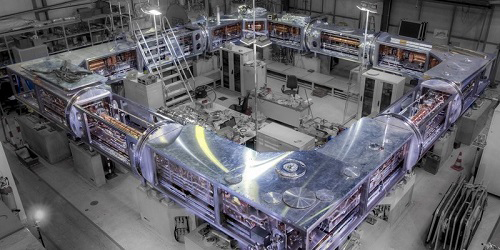Ejected Electron Slows Molecule’s Rotation
Small molecular ions are important in atmospheric chemistry and astrophysics. The diatomic carbon ion is a heavily studied example that has been a source of mystery: When highly excited, most molecular ions have a wide range of lifetimes before converting to a neutral form. But many ions shed their electron with a specific lifetime of about 3 milliseconds. Now Viviane Schmidt of the Max Planck Institute for Nuclear Physics (MPIK) in Germany and her colleagues have solved the mystery by discovering a molecular process that involves a change in angular momentum [1, 2]. If the molecule spins rapidly enough, a certain electronically excited state transitions to a state only if the departing electron takes away some of the molecule’s angular momentum, a requirement that leads to the measured lifetime.
For the conversion from to to occur, the final state must have lower energy than the initial state. However, in a rapidly rotating molecule, the energies of the electronic states differ from those in a nonrotating molecule. Schmidt and her colleagues found theoretically that when has 155 or more quanta of angular momentum, a certain excited electronic state has less energy than the state to which it would normally convert. The transition is impossible unless the ejected electron removes enough angular momentum to shift the final state’s energy below the initial state’s energy.
The researchers’ theory for such “rotationally assisted” transitions showed that processes requiring a transfer of six units of angular momentum are responsible for the 3-millisecond lifetime the team observed at the MPIK Cryogenic Storage Ring. Schmidt expects similar processes to occur in other highly excited molecules both in the atmosphere and in nuclear-fusion plasmas.
–David Ehrenstein
David Ehrenstein is a Senior Editor for Physics Magazine.
References
- V. C. Schmidt et al., “Autodetachment of diatomic carbon anions from long-lived high-rotation quartet states,” Phys. Rev. Lett. 133, 183001 (2024).
- V. C. Schmidt et al., “Unimolecular processes in diatomic carbon anions at high rotational excitation,” Phys. Rev. A 110, 042828 (2024).




